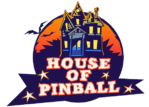Flippers are the heart of pinball. Without them, pinball wouldn’t be a game of skill — it would be pure chance. From their revolutionary debut in 1947 to the advanced flipper mechanics found in today’s machines, the evolution of the pinball flipper tells the story of how pinball itself became what it is today.
At House of Pinball, we believe that understanding the mechanics and design behind a game helps collectors and new buyers make smarter, more confident choices when looking for a pinball machine for sale.
Let’s flip back in time.
🔄 1947: The Birth of the Flipper
Before 1947, pinball was entirely passive. Players pulled a plunger to launch the ball and watched as it bounced around the playfield. Then came Gottlieb’s “Humpty Dumpty” — the first pinball machine with flippers.
- Number of flippers: 6 (mounted on the sides, facing outward)
- Designer: Harry Mabs
- Impact: Transformed pinball from a game of chance into a game of skill.
It was a watershed moment. The pinball flipper didn’t just change how we played — it redefined the entire pinball industry.
🔧 1950s–1970s: Flippers Become Strategic
As pinball machines matured, designers experimented with:
- Flipper placement: Moving them to the bottom center of the playfield (still standard today)
- Reduced flipper count: From 6+ to 2-3, creating more strategy and precision
- Mechanical improvements: Stronger solenoids, snappier response
These decades introduced a generation to the “two-flipper setup” we still use — allowing players to trap the ball, aim, and shoot with skill. Collectors often seek out Williams and Bally EM machines from this era for their nostalgic and strategic gameplay.
⚡ 1980s–1990s: The Rise of Complexity
The golden age of pinball saw the rise of Pat Lawlor, Steve Ritchie, and other legendary designers. They pushed flipper design to new heights.
Key Innovations:
- Upper flippers: Opening new shots and modes (see The Addams Family or Whirlwind)
- Cradling techniques: Players could now hold and aim with one flipper while planning the next move.
- Combo shots: Designed specifically for skilled players to hit sequential shots
- Flipper-coded rulesets: Holding a flipper could activate alternate modes or skill shots
Machines from this era are in high demand and can be found under our curated pinball machine for sale listings. They’re often a perfect balance of playability, innovation, and collector value.
🎮 2000s–Today: Digital Precision & Modern Power
Modern pinball machines, like those produced by Stern, Jersey Jack, and Spooky Pinball, have taken flipper technology into the digital era.
Today’s Features:
- Precision flipper boards: Better responsiveness, heat protection, and durability
- Power level settings: Customizable for tournament, home, or beginner play
- Code integration: Flippers trigger hidden content, challenges, or audio clips
- Anti-burnout designs: Avoid coil overheating during long sessions
If you’re buying a modern pinball machine for sale, these advancements offer a smoother, more reliable experience—especially for competitive or frequent players.
🧠 Quick Comparison: Flipper Evolution by Era
| Era | Flipper Count | Innovation Highlight | Ideal For |
|---|---|---|---|
| 1947–1950s | 4–6 | First-ever flippers | Vintage collectors |
| 1960s–70s | 2–3 | Strategic gameplay | EM lovers, beginners |
| 1980s–90s | 2–4 | Upper flippers, complex rules | Classic players, nostalgia fans |
| 2000s–Now | 2–4 | Code-based mechanics, precision | Competitive/tournament play |
💬 Buyer Tip: What to Look for in Flippers
When browsing a pinball machine for sale, flipper condition is crucial. Worn flippers can ruin gameplay and signal poor maintenance.
Ask these questions:
✅ Are flippers snappy or sluggish?
✅ Is there play in the flipper shafts (side-to-side movement)?
✅ Do the flippers return to rest quickly and evenly?
✅ Has the machine had its flipper coils or bushings replaced recently?
At House of Pinball, all machines are tested, tuned, and serviced, ensuring optimal flipper response. We include flipper condition in every product listing, so you buy with confidence.
🔍 Did You Know?
- The average flipper solenoid fires over 100,000 times in a machine’s life.
- Some machines let you adjust flipper strength for softer or faster gameplay.
- In competitive pinball, flipper responsiveness can be the difference between 1st and 5th place.
🛒 Why Flippers Matter When Buying
The condition and design of flippers affect:
- Playfield control
- Ball trapping and aiming
- Replay value
- Skill development
Whether you’re buying a vintage EM, a 1990s Bally/Williams classic, or a brand-new Stern, flippers are at the heart of the experience.
Our expert team at House of Pinball inspects every machine with these principles in mind — because we know flippers make or break the game.
🎯 Final Thoughts: Why Flippers Are More Than Just Parts
From a humble invention in 1947 to the digital-age marvels of today, flippers have evolved into more than just a way to hit the ball — they define how we play, what we master, and how a machine feels.
If you’re in the market for a pinball machine for sale, understanding flipper design helps you choose the machine that best fits your playing style, experience level, and long-term goals.
🛒 Ready to Find a Machine with the Perfect Flip?
Browse our curated collection of pinball machines for sale at House of Pinball.

